Project 4 / Scene Recognition with Bag of Words
Introduction
Bag of Words (BoW) model used to play a significant role in computer vision. Although it has been graduately replaced by recent deep learning methods, it is still worth our while to learn what the conventional visual recognition pipeline looks like. In this project, I have finished all the basic requirements as well as the following extra credits: (Note that, I used 300 for the BoW vocabulary size and 256 for GMM vocabulary size, while in code, I set 100 for BoW and 256 for GMM.
- Experiment with many different vocabulary sizes and report performance. I experimented 10, 20, 50, 100, 200, 300, 400, 1000, respectively. (3pts)
- Train the SVM with more sophisticated kernels such as Gaussian/RBF. I used RBF kernel for nonlinear SVM. (3pts)
- Add complementary features. In this project, I added GIST descriptor. (5pts)
- Used more sophisticated feature encoding scheme. In this project, I used Fisher encoding. (5pts)
- The best accuracy I obatined is 81.9%, which is obatined via fusion features (GIST+SIFT_Fisher_Vector).
- All basic experiments are run within 4 minutes on a i7-6700K CPU with 32GB RAM.
Basic Experiments
1. Tiny images plus nearest neighbor classifier
I implemented the tiny images features and then normalized them. The code is as follows:
% get tiny images features from raw images
function image_feats = get_tiny_images(image_paths)
num = size(image_paths,1);
rows = 16;
cols = 16;
for i = 1:num
img = imread(image_paths{i});
resize_img = imresize(img, [rows cols]);
image_feats_m(i,:) = reshape(resize_img,[1 rows*cols]);
image_feats(i,:) = double(image_feats_m(i,:));
image_feats(i,:) = image_feats(i,:) - repmat(mean(image_feats(i,:)),...
size(image_feats(i,:),1),size(image_feats(i,:),2));
image_feats(i,:) = image_feats(i,:)/norm(image_feats(i,:),2);
end
end
Then I implemented the nearest neighbor classifier (1-NN). The code is as follows:
% 1-NN classifier
function predicted_categories = nearest_neighbor_classify(train_image_feats, train_labels, test_image_feats)
D = vl_alldist2(train_image_feats',test_image_feats','L2');
[~,idx] = sort(D,'ascend');
% 1-nn
idx_min = idx(1,:);
predicted_categories = cell(size(test_image_feats,1),1);
for i = 1:size(test_image_feats,1)
predicted_categories{i} = train_labels{idx_min(i)};
end
end
Combining the tiny images and 1-NN classifier, I achieved 22.5% accuracy. The confusion matrix is shown as follows:

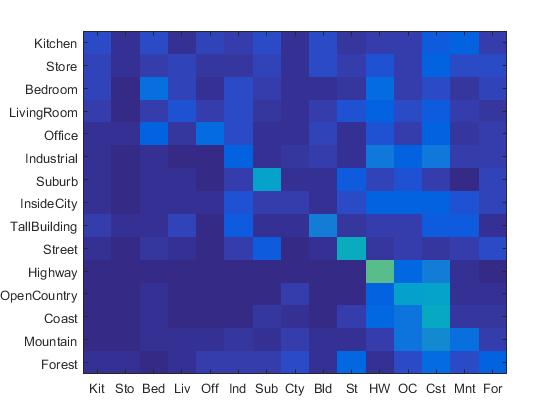
|
2. Tiny images plus linear SVM classifier
I implemented the linear SVM classifier. The code is as follows:
% linear SVM classifier
function predicted_categories = svm_classify(train_image_feats, train_labels, test_image_feats)
categories = unique(train_labels);
num_categories = length(categories);
LAMBDA = .0001;
for i = 1:num_categories
matching_indices = strcmp(categories{i}, train_labels);
matching_indices = double(matching_indices);
matching_indices(find(matching_indices==0)) = -1;
svm_train_labels = double(matching_indices);
[w(:,i),b(i,1)] = vl_svmtrain(double(train_image_feats'), svm_train_labels, LAMBDA);
end
confidence = exp(w'*test_image_feats'+ repmat(b,1,size(test_image_feats,1)));
[~,idx] = max(confidence);
for i = 1:size(test_image_feats,1)
predicted_categories{i,1} = categories{idx(i)};
end
end
Combining the tiny images and linear SVM classifier, I achieved 19.2% accuracy. The confusion matrix is shown as follows:

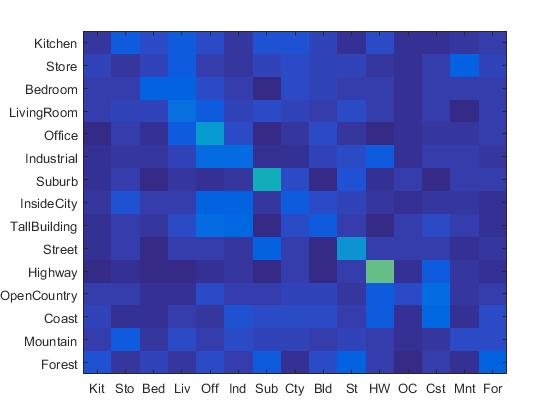
|
3. SIFT BoW features plus 1-NN classifier
I implemented the SIFT BoW features via two steps. First, I set the size of the vocabulary as 200, and constructed the vocabulary using the following code:
% bulid vocabulary for SIFT descriptors
function vocab = build_vocabulary( image_paths, vocab_size )
SIFT_features = [];
for i = 1:size(image_paths,1)
img = single(imread(image_paths{i}));
[~, SIFT_features_delta] = vl_dsift(img,'fast','Step',8,'Size',8);
SIFT_features = [SIFT_features,SIFT_features_delta];
end
[centers, ~] = vl_kmeans(single(SIFT_features), vocab_size);
vocab = centers';
end
Second, I constructed the histogram features using the vocabulary and the SIFT descriptors from training and testing images. The code is as follows:
% get bags of sifts features
function image_feats = get_bags_of_sifts(image_paths)
load('vocab.mat')
image_feats = [];
vocab_size = size(vocab, 1);
for i = 1:size(image_paths,1)
img = single(imread(image_paths{i}));
[~, SIFT_features] = vl_dsift(img,'Fast','Step',8,'Size',8) ;
D = vl_alldist2(vocab',single(SIFT_features));
[~,idx] = sort(D);
idx_min = idx(1,:);
unit_vec = eye(vocab_size);
sift_hist = sum(unit_vec(idx_min,:),1);
image_feats(i,:) = sift_hist./norm(sift_hist,2);
end
end
Combining the SIFT BoW features and 1-NN classifier, I achieved 50.8% accuracy. The confusion matrix is shown as follows:

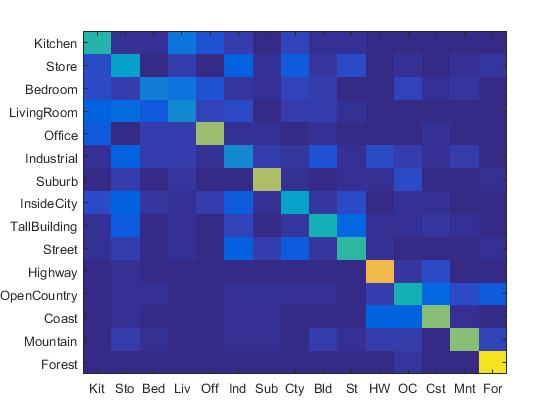
|
4. SIFT BoW features plus linear SVM classifier
Combining the SIFT BoW features and linear SVM classifier, I achieved 67.3% accuracy. The confusion matrix is shown as follows:

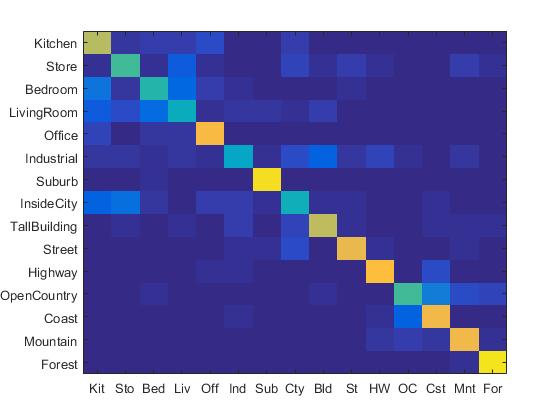
|
Some samples from the recognition are shown as follows:
| Category name | Accuracy | Sample training images | Sample true positives | False positives with true label | False negatives with wrong predicted label | ||||
|---|---|---|---|---|---|---|---|---|---|
| Kitchen | 0.620 |  |
 |
 |
 |
 Bedroom |
 LivingRoom |
 TallBuilding |
 Bedroom |
| Store | 0.520 |  |
 |
 |
 LivingRoom |
 Bedroom |
 Forest |
 Office |
|
| Bedroom | 0.410 |  |
 |
 |
 |
 LivingRoom |
 LivingRoom |
 Kitchen |
 LivingRoom |
| LivingRoom | 0.430 |  |
 |
 |
 |
 Industrial |
 Bedroom |
 Bedroom |
 Kitchen |
| Office | 0.810 |  |
 |
 |
 |
 InsideCity |
 Bedroom |
 Bedroom |
 LivingRoom |
| Industrial | 0.420 |  |
 |
 |
 |
 Suburb |
 TallBuilding |
 Kitchen |
 TallBuilding |
| Suburb | 0.890 |  |
 |
 |
 |
 InsideCity |
 OpenCountry |
 OpenCountry |
 LivingRoom |
| InsideCity | 0.410 |  |
 |
 |
 |
 TallBuilding |
 Industrial |
 Store |
 Kitchen |
| TallBuilding | 0.710 |  |
 |
 |
 |
 Office |
 InsideCity |
 Industrial |
 Industrial |
| Street | 0.790 |  |
 |
 |
 |
 OpenCountry |
 Bedroom |
 InsideCity |
 Store |
| Highway | 0.830 |  |
 |
 |
 |
 Mountain |
 Street |
 Coast |
 Office |
| OpenCountry | 0.550 |  |
 |
 |
 |
 Coast |
 Industrial |
 Mountain |
 Mountain |
| Coast | 0.780 |  |
 |
 |
 |
 OpenCountry |
 Mountain |
 Highway |
 Highway |
| Mountain | 0.820 |  |
 |
 |
 |
 Store |
 Store |
 Coast |
 Forest |
| Forest | 0.950 |  |
 |
 |
 |
 TallBuilding |
 OpenCountry |
 Mountain |
 Mountain |
| Category name | Accuracy | Sample training images | Sample true positives | False positives with true label | False negatives with wrong predicted label | ||||
Extra Credits
1. Experiment with many different vocabulary sizes (3pts)
I experimented with many different vocabulary sizes such as 10, 20, 50, 100, 200, 300, 400, 1000. Their confusion matrix are shown as follows. (The first row: 10, 20, 50, 100 (from left to right). The second row: 200, 300, 400, 1000 (from left to right).)
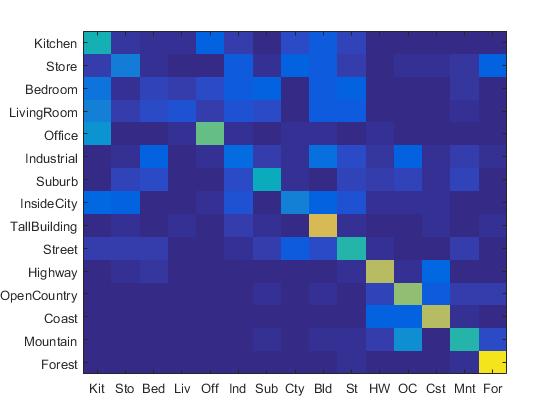
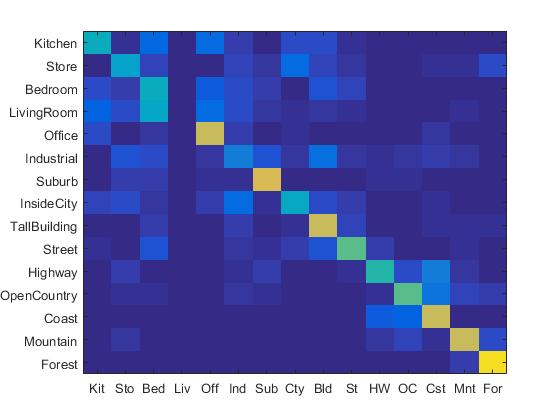
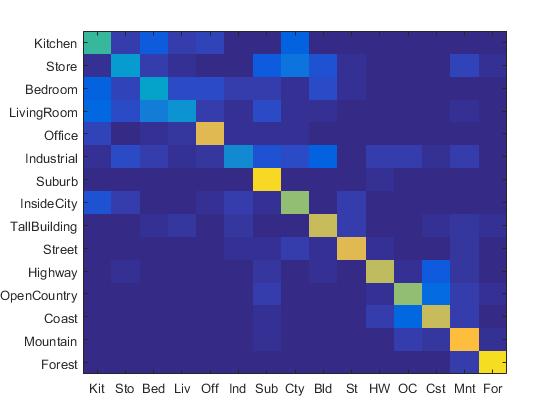
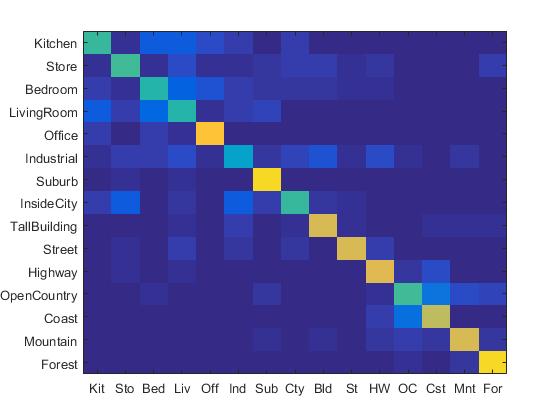
|

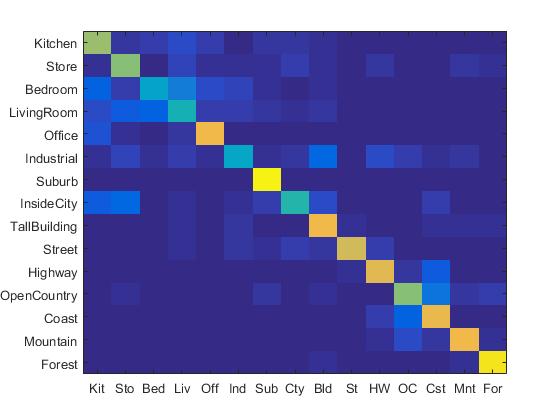
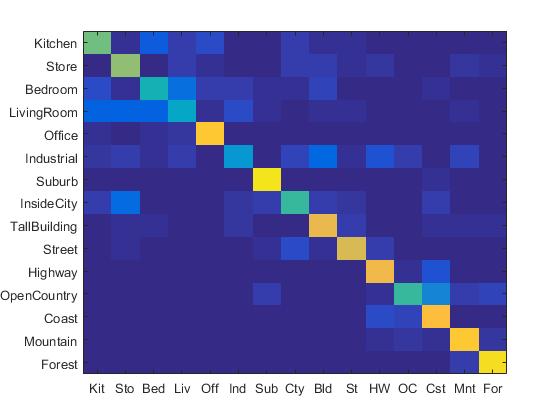
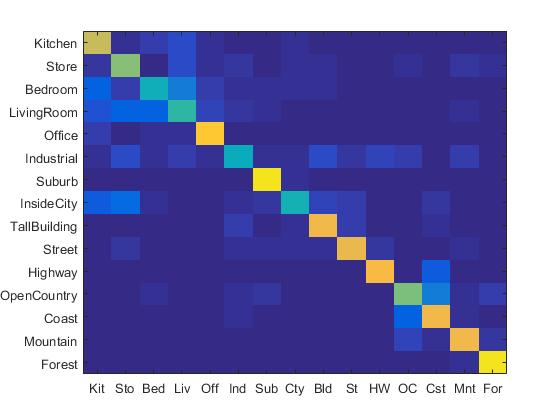
|
I also plot an "accuracy vs. vocabulary size" figure, as shown in the following:
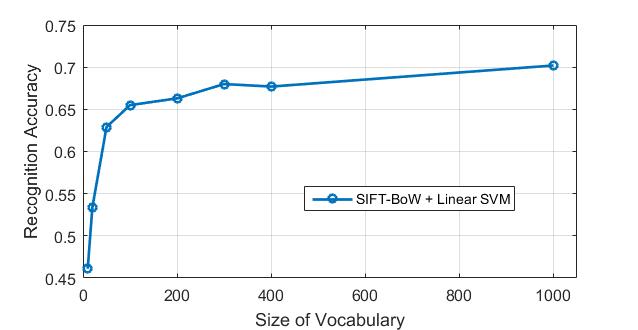
|
2. Using RBF kernel for nonlinear SVM (3pts)
I implemented the non-linear SVM with RBF kernel using the MATLAB built-in svmtrain function. The code is as follows:
% non-linear SVM with RBF kernel
function predicted_categories = nonlinear_svm_classify(train_image_feats, train_labels, test_image_feats)
categories = unique(train_labels);
num_categories = length(categories);
LAMBDA = .0004;
for i = 1:num_categories
matching_indices = strcmp(categories{i}, train_labels);
matching_indices = double(matching_indices);
matching_indices(find(matching_indices==0)) = -1;
svm_train_labels = double(matching_indices);
svm_model{i} = fitcsvm(double(train_image_feats), svm_train_labels, 'KernelFunction','rbf');
end
for i = 1:num_categories
[~,scores] = predict(svm_model{i},test_image_feats);
confidence(i,:) = (scores(:,2))';
end
[~,idx] = max(confidence);
for i = 1:size(test_image_feats,1)
predicted_categories{i,1} = categories{idx(i)};
end
end
I tested the nonlinear SVM with tiny images and SIFT-BoW features. The results for tiny images are shown as follows:

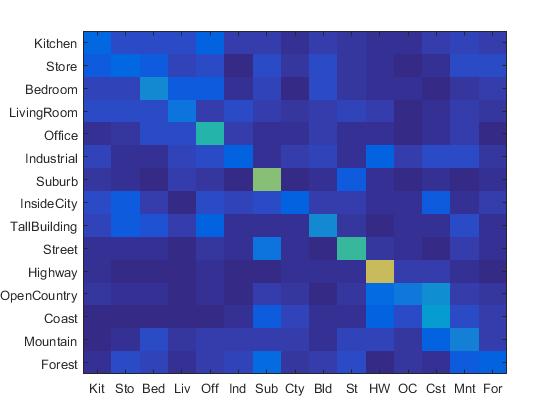
|
The results for SIFT-BoW features are shown as follows:

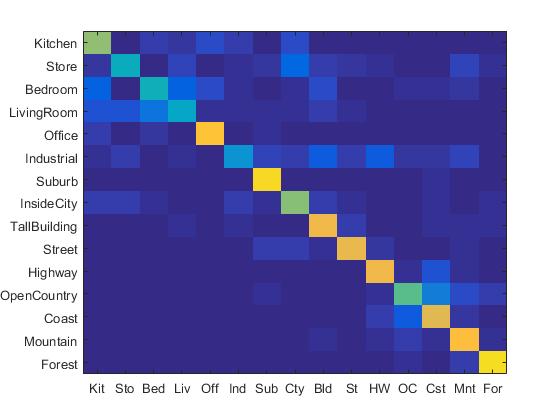
|
We can see both results are higher than the linear SVM.
3. GIST descriptor (5pts)
I implemented the GIST features with the extra LMgist.m and imresizecrop.m downloaded from the GIST project page. My code is as follows:
% GIST descriptor
function image_feats = get_gist_vector(image_paths)
image_feats = [];
clear param
for i = 1:size(image_paths,1)
img = single(imread(image_paths{i}));
param.imageSize = [256 256];
param.orientationsPerScale = [8 8 8 8]; % number of orientations per scale
param.numberBlocks = 4;
param.fc_prefilt = 4;
image_feats(i,:) = LMgist(img, '', param);
end
end
For the proj4.m file, I added the following part to the feature extraction section:
% *******************extra credit (GIST)******************
case 'gist descriptor'
train_image_feats = get_gist_vector(train_image_paths);
test_image_feats = get_gist_vector(test_image_paths);
save('gist_features.mat', 'train_image_feats','test_image_feats');
% load('gist_features.mat');
% ****************end of extra credit (GIST)***************
If I only used GIST and linear SVM, I can obtain the following results:

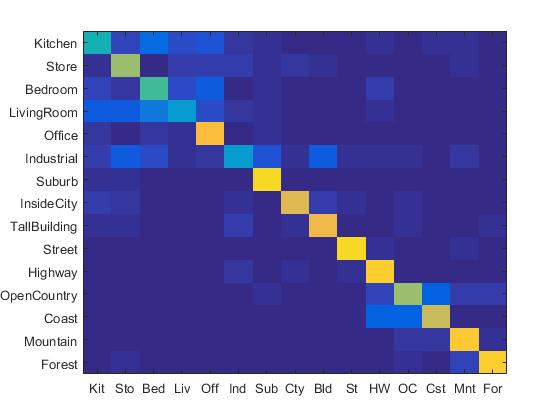
|
If I simply concatenated GIST to the SIFT-BoW features and used linear SVM,, I can obtain the following results:

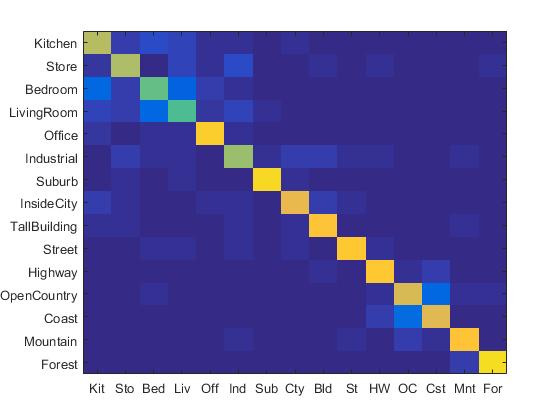
|
4. Fisher Encoding (5pts)
I implemented the fisher encoding via two steps. First, I constructed a vocabulary with Gaussian mixture model. The code is as follows:
% build GMM vocabulary
function [means, covariances, priors] = build_GMM_vocabulary( image_paths, numClusters )
SIFT_features = [];
for i = 1:size(image_paths,1)
img = single(imread(image_paths{i}));
[~, SIFT_features_delta] = vl_dsift(img,'fast','Step',8,'Size',8);
SIFT_features = [SIFT_features,SIFT_features_delta];
end
[means, covariances, priors] = vl_gmm(double(SIFT_features), numClusters);
end
Second, I constructed fisher vector using the vocabulary. The code is as follows:
% get fisher vector with the GMM vocabulary
function image_feats = get_fisher_vector(image_paths, means, covariances, priors)
load('vocab_GMM.mat')
image_feats = [];
for i = 1:size(image_paths,1)
img = single(imread(image_paths{i}));
[~, SIFT_features] = vl_dsift(img,'Fast','Step',8,'Size',8) ;
image_feats(i,:) = vl_fisher(double(SIFT_features), means, covariances, priors, 'Improved', 'Fast');
end
end
Finally, I added some code to the proj4.m file:
% *******************extra credit (Fisher Vector)******************
case 'sift fisher vector'
if ~exist('vocab_GMM.mat', 'file')
fprintf('No existing visual word vocabulary found. Computing one from training images\n')
numClusters = 256;
[means, covariances, priors] = build_GMM_vocabulary(train_image_paths, numClusters);
save('vocab_GMM.mat', 'means', 'covariances', 'priors')
end
train_image_feats = get_fisher_vector(train_image_paths, means, covariances, priors);
test_image_feats = get_fisher_vector(test_image_paths, means, covariances, priors);
save('sift_FV_features.mat', 'train_image_feats','test_image_feats');
% load('sift_FV_features.mat');
% dimension reduction by PCA
reduced_dim = 512;
num_train = size(train_image_feats,1);
num_test = size(test_image_feats,1);
[~,new_feats] = pca([train_image_feats;test_image_feats]);
new_feats = new_feats(:,1:reduced_dim);
train_image_feats = new_feats(1:num_train,:);
test_image_feats = new_feats(num_train+1:num_train+num_test,:);
save('sift_FV_features_PCA.mat', 'train_image_feats','test_image_feats');
% load('sift_FV_features_PCA.mat');
% ****************end of extra credit (Fisher Vector)***************
Since the dimension of Fisher vector is too large, I also implemented a PCA dimension reduction for Fisher vector. If I directly run linear SVM on top of the original Fisher vector, I obtained the following results:

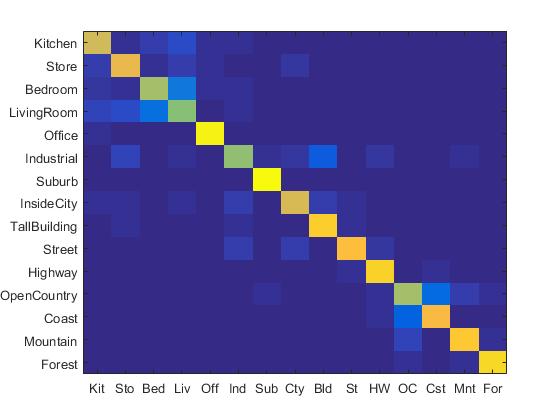
|
If I used PCA to reduce the dimension of Fisher vector to 512, then I obtained the following results:

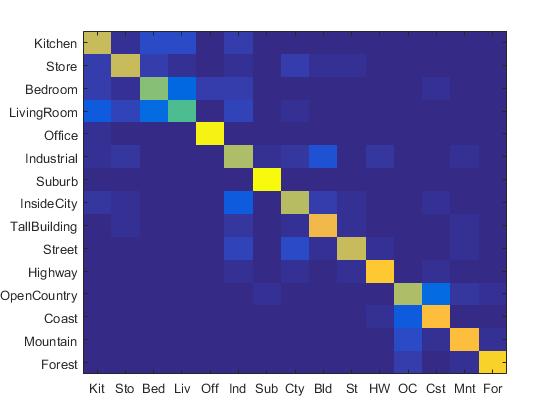
|
Best Obtained Accuracy
I first reduced dimension of Fisher vector to 512 via PCA and then concatenated GIST to the SIFT fisher vector, constructing fusion features with dimension of 1024. I add the code to the proj4.m file, shown as follows:
% *******************extra credit (GIST+SIFT_fv)******************
case 'gist + sift_fv'
if ~exist('vocab_GMM.mat', 'file')
fprintf('No existing visual word vocabulary found. Computing one from training images\n')
numClusters = 256; %Larger values will work better (to a point) but be slower to compute
[means, covariances, priors] = build_GMM_vocabulary(train_image_paths, numClusters);
save('vocab_GMM.mat', 'means', 'covariances', 'priors')
end
train_image_feats = get_fisher_vector(train_image_paths, means, covariances, priors);
test_image_feats = get_fisher_vector(test_image_paths, means, covariances, priors);
% dimension reduction by PCA
reduced_dim = 512;
num_train = size(train_image_feats,1);
num_test = size(test_image_feats,1);
[~,new_feats] = pca([train_image_feats;test_image_feats]);
new_feats = new_feats(:,1:reduced_dim);
train_image_feats = new_feats(1:num_train,:);
test_image_feats = new_feats(num_train+1:num_train+num_test,:);
train_image_feats_part1 = train_image_feats;
test_image_feats_part1 = test_image_feats;
% load('sift_FV_features_PCA.mat');
% train_image_feats_part1 = train_image_feats;
% test_image_feats_part1 = test_image_feats;
train_image_feats_part2 = get_gist_vector(train_image_paths);
test_image_feats_part2 = get_gist_vector(test_image_paths);
save('gist_features.mat', 'train_image_feats','test_image_feats');
% load('gist_features.mat');
% train_image_feats_part2 = train_image_feats;
% test_image_feats_part2 = test_image_feats;
train_image_feats = [train_image_feats_part1,train_image_feats_part2];
test_image_feats = [test_image_feats_part1,test_image_feats_part2];
save('gist_sift_hist_features.mat', 'train_image_feats','test_image_feats');
% load('gist_sift_hist_features.mat');
% ****************end of extra credit (GIST+SIFT_fv)***************
I simply used linear SVM to classify these features and obtained the following results:

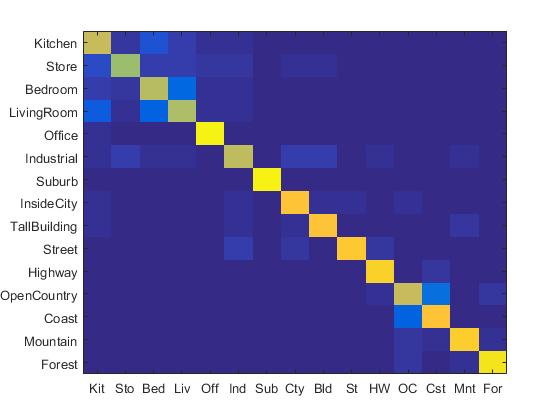
|
| Category name | Accuracy | Sample training images | Sample true positives | False positives with true label | False negatives with wrong predicted label | ||||
|---|---|---|---|---|---|---|---|---|---|
| Kitchen | 0.730 |  |
 |
 |
 |
 TallBuilding |
 InsideCity |
 Store |
 Bedroom |
| Store | 0.650 |  |
 |
 |
 |
 Bedroom |
 TallBuilding |
 Highway |
 TallBuilding |
| Bedroom | 0.690 |  |
 |
 |
 |
 LivingRoom |
 Store |
 LivingRoom |
 Kitchen |
| LivingRoom | 0.680 |  |
 |
 |
 |
 Industrial |
 Bedroom |
 Kitchen |
 Store |
| Office | 0.980 |  |
 |
 |
 |
 Bedroom |
 LivingRoom |
 Kitchen |
 Kitchen |
| Industrial | 0.710 |  |
 |
 |
 |
 InsideCity |
 InsideCity |
TallBuilding |
 LivingRoom |
| Suburb | 0.980 |  |
 |
 |
 |
 LivingRoom |
 Kitchen |
||
| InsideCity | 0.850 |  |
 |
 |
 |
 Highway |
 Industrial |
 TallBuilding |
 Industrial |
| TallBuilding | 0.850 |  |
 |
 |
 |
 Industrial |
 InsideCity |
 Kitchen |
 Industrial |
| Street | 0.860 |  |
 |
 |
 |
 InsideCity |
 InsideCity |
 InsideCity |
 Industrial |
| Highway | 0.900 |  |
 |
 |
 |
 Store |
 Street |
 Kitchen |
 LivingRoom |
| OpenCountry | 0.720 |  |
 |
 |
 |
 Coast |
 Coast |
 Coast |
 Coast |
| Coast | 0.850 |  |
 |
 |
 |
 OpenCountry |
 OpenCountry |
 OpenCountry |
 OpenCountry |
| Mountain | 0.890 |  |
 |
 |
 |
 TallBuilding |
 Forest |
 Forest |
 OpenCountry |
| Forest | 0.940 |  |
 |
 |
 |
 Mountain |
 OpenCountry |
 OpenCountry |
 Mountain |
| Category name | Accuracy | Sample training images | Sample true positives | False positives with true label | False negatives with wrong predicted label | ||||